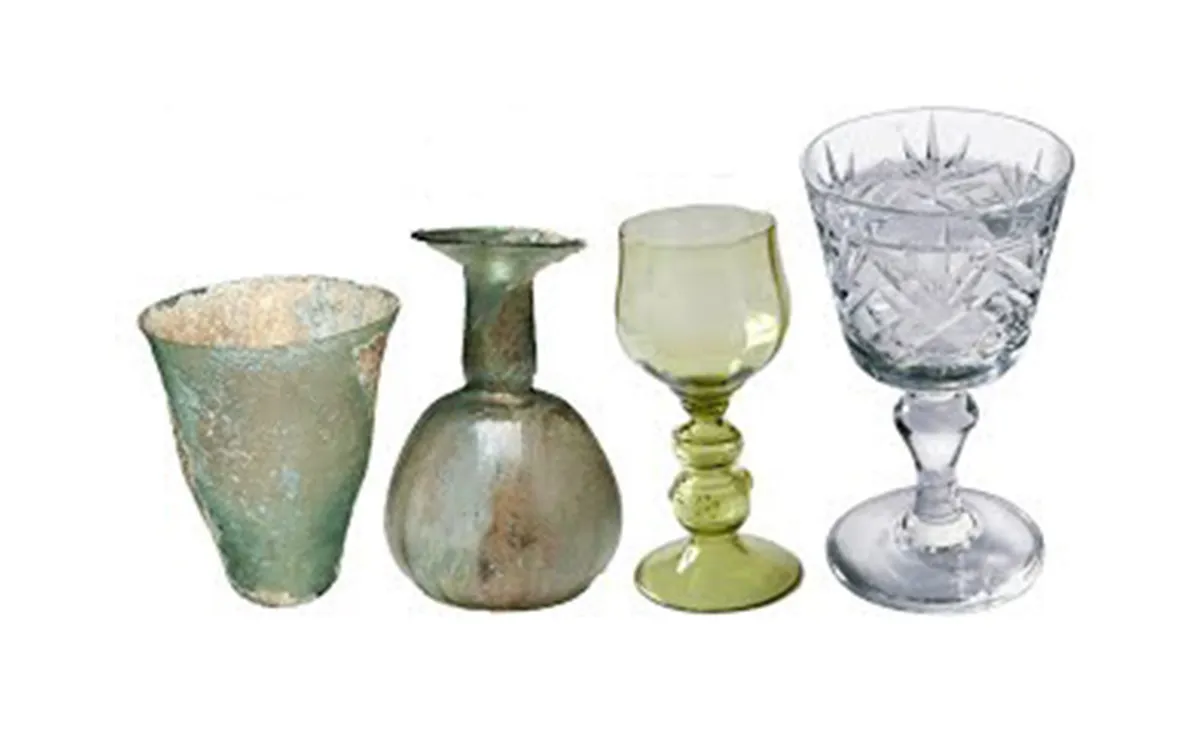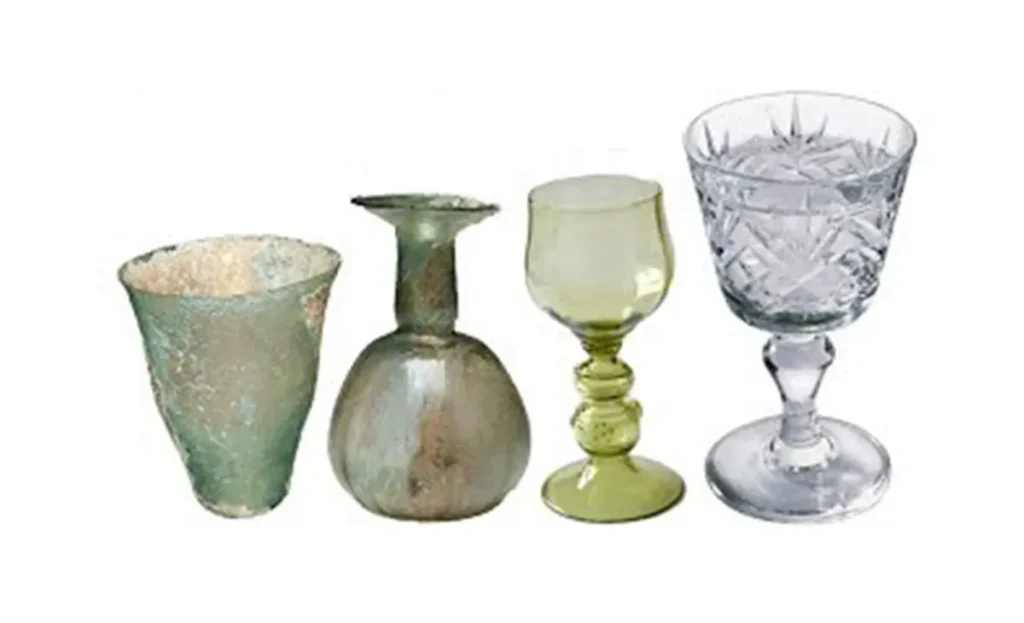
The invention of glass bottles dates back to around 1500 B.C., with the earliest examples originating in ancient Egypt and Mesopotamia. These early vessels were not transparent but instead core-formed, often small, and primarily used for precious oils and perfumes.
Table of Contents
c. 1500 BC: The First Glass Bottles in Mesopotamia and Egypt
Around 1500 BC, the first glass bottles emerged in Mesopotamia and Egypt. These early vessels were crafted using a method known as core-forming—a technique quite different from later glassblowing. Artisans would shape a core from materials like clay or sand into the form of a bottle, then coat it with molten glass. After cooling, the core was removed, leaving behind a small, thick-walled container typically just a few centimeters high. The surfaces were often uneven and hand-finished, giving each bottle a distinct appearance.
Key Features and Manufacture
These bottles were made from an early type of soda-lime-silica glass, often using natron to help melt the silica at lower temperatures. They commonly appeared in shades of blue, green, and sometimes featured mosaic-like decorations. Some were even designed to imitate precious stones or had added trailed bands for ornamentation. Due to the effort required to produce them, these bottles were considered luxury items, primarily used to store perfumes, oils, and medicines valued by elite members of society.
Archaeological Findings and Notable Sites
Well-preserved examples of these early glass bottles have been found in Egyptian tombs such as those in Thebes and Amarna, often placed as burial goods for royalty and high-status individuals. Similar vessels have been uncovered in Mesopotamian sites including Eridu, as well as in Phoenician coastal settlements. The dry conditions in regions like Egypt contributed to the remarkable preservation of these fragile objects, many of which can be seen in museums today.
Economic and Cultural Context
The production of glass bottles was labor-intensive and costly, restricting their use to ceremonial, ritual, or high-status applications. Before bottles became more common, glass was mainly used for smaller items like beads and amulets. The innovation of bottle-shaped vessels opened new functional and artistic possibilities for glass, establishing a foundation for future advancements in glassmaking.
c. 1st Century BC: Glassblowing is Born in Roman Syria
Around the 1st century BC, a major breakthrough took place in glassmaking with the invention of glassblowing in Roman Syria. This innovation transformed how glass bottles were made, allowing them to be produced more quickly, in greater variety, and at a lower cost.
New Ideas and Glassblowing Methods
Syrian glassmakers along the Syro-Palestinian coast introduced the use of a hollow metal blowpipe, which allowed them to inflate and shape molten glass with surprising speed. They also began using specialized tools such as the punty (or pontil), marver, jacks, and paddles. These instruments gave artisans better control over the form and surface of the glass, enabling more intricate shapes and decorative patterns.
Big Changes in Bottle Making
Thanks to glassblowing, bottles could be made with thinner walls, using less material and reducing their weight. This efficiency opened the door to mass production—a significant improvement over earlier techniques like core-forming. Artisans began experimenting with a wider variety of bottle shapes, colors, and designs. Over time, Roman glass shifted from being purely decorative to serving everyday practical purposes.
How it Impacted People and the Economy
As production scaled up, the price of glassware dropped dramatically. By the mid-1st century AD, even a simple glass cup could be purchased for just a copper coin. What was once a luxury became accessible to ordinary people, who began using glass bottles commonly for storing wine, oil, and perfumes.
Spreading the Craft and Growing an Industry
Glassblowing technology spread quickly throughout the Roman Empire, reaching Italy, Gaul, Germany, and even distant provinces like Britain. Workshops first emerged in port cities in the eastern Mediterranean, later expanding to regions such as Egypt. This expansion wasn’t limited to bottles—improved glassmaking also contributed to new uses like mosaic tesserae and early forms of window glass. As the craft traveled, it blended artistic styles from different cultures, reflecting a mix of Eastern and Roman influences.
The Historical Picture
The Roman annexation of Syria in 64 BC, combined with the stability of the Pax Romana, helped create ideal conditions for trade and the movement of artisans. This period saw blown glass bottles become more widespread, diverse, and economically important across the empire.
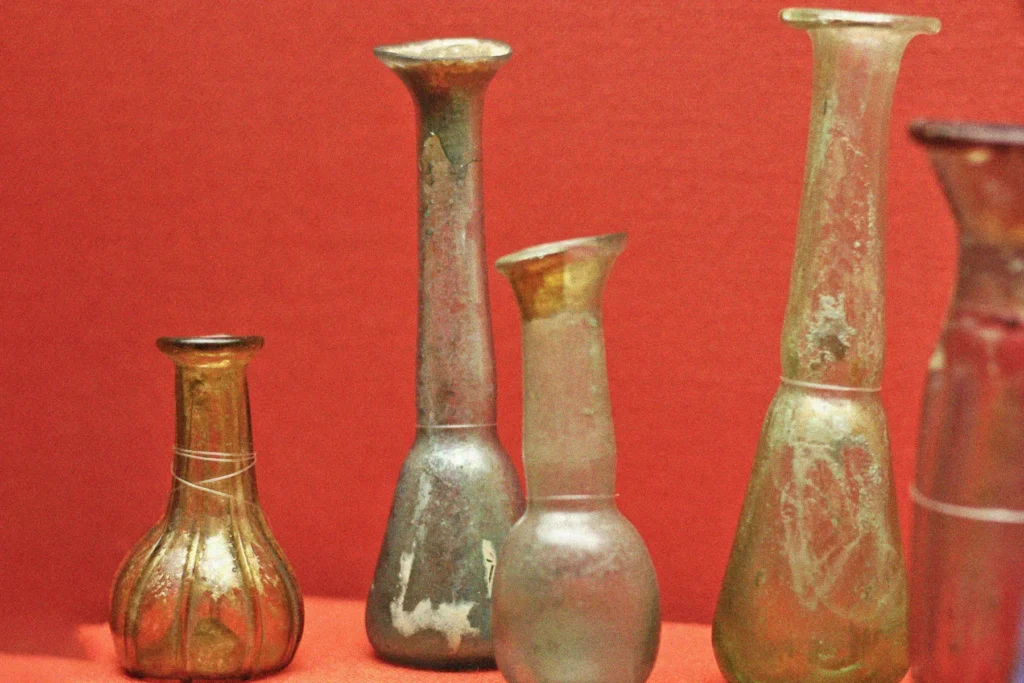
1st Century AD: Roman Expansion of Glass Bottles
The 1st century AD marked a major turning point in the history of glassmaking, with the Roman Empire emerging as a center of production and innovation. Adopting and refining techniques originally developed in the Syro-Palestinian region—particularly in cities like Sidon—Roman artisans spread glassblowing and mold-forming technologies throughout their vast empire. The stable conditions of the Augustan Pax Romana allowed both local and immigrant glassmakers to establish successful workshops across Italy and other Roman provinces.
Practical Advantages of Roman Glassblowing
Roman glassblowing offered several key advantages. It was highly efficient, using less raw material to create bottles and jars with thin yet durable walls. This method was not only faster than earlier techniques like core-forming, but also reduced labor costs, making glass containers more affordable. Artisans could produce a wide variety of shapes and sizes, from delicate vials to sturdy flasks. The Romans were also early adopters of glass recycling, melting down broken glass for reuse—a practice noted by writers such as Martial and Juvenal.
Glass Bottles as Status Symbols and Everyday Items
Initially, glass bottles were luxury items owned by the wealthy. Elegant perfume bottles (unguentaria), wine decanters, and finely crafted jugs served as displays of status, and glass urns were sometimes used in cremation rituals. With the introduction of mold-blowing, standardized bottle shapes became common, simplifying the storage and transport of goods like wine, oil, and perfumes.
Key Changes by Mid-to-Late 1st Century AD
By the middle of the century, glass had become increasingly accessible. The geographer Strabo noted that a simple glass cup could be bought for just one copper coin, indicating that glass was no longer exclusive to the elite. As glassware grew in popularity, it began to replace ceramic containers for many uses. Technical improvements in furnace design also enabled new applications, including glass tiles for mosaics and the first production of window glass.
Types and Uses of Roman Glass Bottles
Roman glass bottles came in many forms. Small, free-blown bottles held perfumes and ointments, while larger mold-blown jugs and decanters were used for serving wine. Sturdy flasks and amphorae stored and transported liquids across the empire. Glass also took on ritual significance, appearing as cremation urns, and played a decorative role in homes through patterned tableware inspired by Greek designs.
The Broader Impact
The spread of glassblowing technology—combined with peace, trade, and mobility across the empire—integrated glass bottles into daily life for millions. Affordable production, effective recycling, and artistic innovation helped lay the foundation for Europe’s glassmaking traditions and transformed how people stored, traded, and used liquids in the ancient world.
1500s–1700s: European Progress and Coal Furnaces
Between the 1500s and 1700s, Glass Bottle production in Europe advanced significantly, led by countries such as England, France, Germany, and Spain. Growing populations and expanding trade created a higher demand for reliable packaging. Craft guilds played an important role during this period by maintaining quality standards and training new glassmakers.
How Venice influenced Technology
In the late 1500s, figures like Jean Carré introduced Venetian glassmaking techniques to England. Carré, originally from Antwerp, secured patents to teach these advanced methods, leading to the production of clear crystallo glass and finely decorated façon de Venise pieces. In 1574, Jacob Verzelini further modernized English glassmaking by importing Spanish barilla, a raw material that resulted in clearer and more affordable glass. This helped transform glass from a luxury item into a more common material. Attracted by these innovations, skilled artisans moved to London, sharing knowledge and improving production techniques. The use of purified materials allowed English glassmakers to create stronger and more transparent bottles.
How Coal Furnaces Changed Production
A major shift occurred in the 1600s when England began using coal instead of wood in glass furnaces, with the first coal-fired facilities built in Newcastle-upon-Tyne around 1610. These furnaces reached higher temperatures, resulting in stronger and more consistent glass bottles. This advancement enabled mass production of bottles for wine, beer, oils, and medicines. As a result, glass containers began to replace those made of clay, leather, or wood.
Industrial Growth and Top Glass Companies
By the late 1700s, large-scale glass manufacturers such as Apsley Pellatt Glass Works and Ravenhead Glass Company emerged in England. Their factories could produce thousands of bottles per week, far surpassing earlier handcrafted methods. Similar industries developed elsewhere in Europe, though often on a smaller scale, with each region cultivating distinct styles and techniques.
Bottle Design, Chemistry, and Standards
Bottle designs evolved quickly during this period. The onion-shaped wine bottle became popular in the late 1600s and remained standard through much of the 18th century, later giving way to mallet and cylinder shapes. Advances in glass chemistry toward the end of the 1700s allowed for lighter and more colorful bottles, which helped producers build brand identity in growing wine and spirits markets. Guilds established consistent rules for materials, sizes, and shapes, leading to standardized bottle types adopted by breweries and vineyards across Europe.
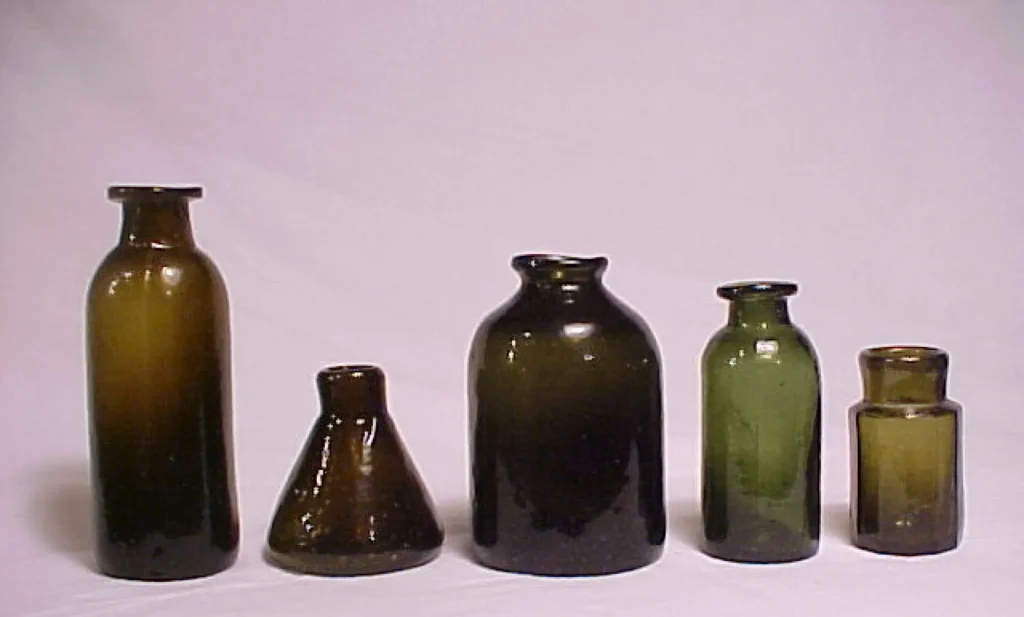
18th Century: Standardization and Cork Innovation
The 18th century brought significant changes to the glass bottle industry, marked by growing standardization and the widespread adoption of cork stoppers. These developments helped shape modern wine and spirit packaging.
Bottle Standardization and Size Regulations
France led the move toward uniform bottle sizes during this period, with the 750-milliliter bottle emerging as a popular choice for its balance of practicality and wine preservation. Two iconic shapes—Bordeaux and Burgundy—were introduced and remain widely used today. A major step toward standardization came in 1735, when the French monarchy established official regulations fixing the bottle capacity at approximately 0.93 liters and setting a glass weight of around 0.98 kg. Although variations persisted, these rules aimed to improve consistency in trade and consumer experience.
Cork Innovation and Improved Wine Storage
The broader use of natural cork stoppers greatly enhanced wine storage. Corks provided an airtight seal that reduced spoilage and allowed bottles to be stored on their side, keeping the cork moist and limiting oxygen exposure. This controlled environment enabled finer wines to age gracefully. For branding and security, many producers began stamping their names directly on corks or sealing bottles with string—wire cages would not appear until later.
Dark Green Glass and Wine Preservation
The shift toward dark green glass became another important innovation. This color helped shield wine from sunlight, slowing spoilage and making bottles more suitable for transport and storage. In an era before printed labels were common, the color and shape of a bottle often indicated its origin and contents.
Lasting Impact on the Wine Industry
The 18th century transitioned wine storage from wooden barrels to glass bottles, supporting more reliable aging and distribution. Standardized, industrially produced bottles became more durable and consistent in size. Classic shapes like the Bordeaux and Burgundy bottles gained prominence, establishing a template for global wine packaging that endures to this day. These innovations laid essential groundwork for the modern wine industry, from mass-produced bottles to refined aging techniques.
Late 19th Century: Machines Take Over Glass Bottle Making
The late 19th century marked a major turning point in the history of glass bottle production, as the industry shifted from handmade craftsmanship to machine-led factory manufacturing.
How Machines Changed Glass Bottle Production
The introduction of semi-automatic and, later, fully automatic machines brought enormous gains in efficiency. Output per worker rose by as much as 171% with early machines, and eventually by 642% to over 3,800% compared to traditional hand-blowing. This transformation also changed the workforce: where skilled glassblowers were once highly valued, factories began hiring machine operators with less training, altering job structures and wages across the industry. Most importantly, automation drastically reduced the cost of each bottle, making glass packaging affordable for everyday products like beverages, medicines, chemicals, and cosmetics.
Michael J. Owens and Automatic Glass Bottle Machines
A major breakthrough came in 1903–1904 when Michael J. Owens introduced the first fully automatic bottle-blowing machine. Capable of producing up to 2,500 bottles per hour—more than ten times the output of a skilled glassblower—the Owens machine revolutionized the speed and scale of production. By the early 20th century, more than 330 of these machines were in operation. Later models, such as the “Genie” in the 1920s, could make as many as 240,000 bottles in a single day, setting new industrial standards.
standard sizes and Industry Growth
Machine production ensured bottles were made with consistent shapes and sizes, which greatly improved reliability for food, drink, and pharmaceutical companies in packaging and branding their products. This uniformity supported mass production on an unprecedented scale, with annual output soon reaching millions of gross (one gross equals 144 bottles). Firms like Owens-Illinois expanded globally, operating dozens of plants and producing billions of glass containers each year throughout the 20th century.
Types and Uses of Machine-Made Glass Bottles
This new era of manufacturing led to standardized bottles for a wide range of uses. Sturdy milk and beer bottles ensured safe delivery and sale of beverages. Small, consistent medicine vials supported advances in healthcare, while glass jars and bottles for home products like preserves, chemicals, and cosmetics became household staples.
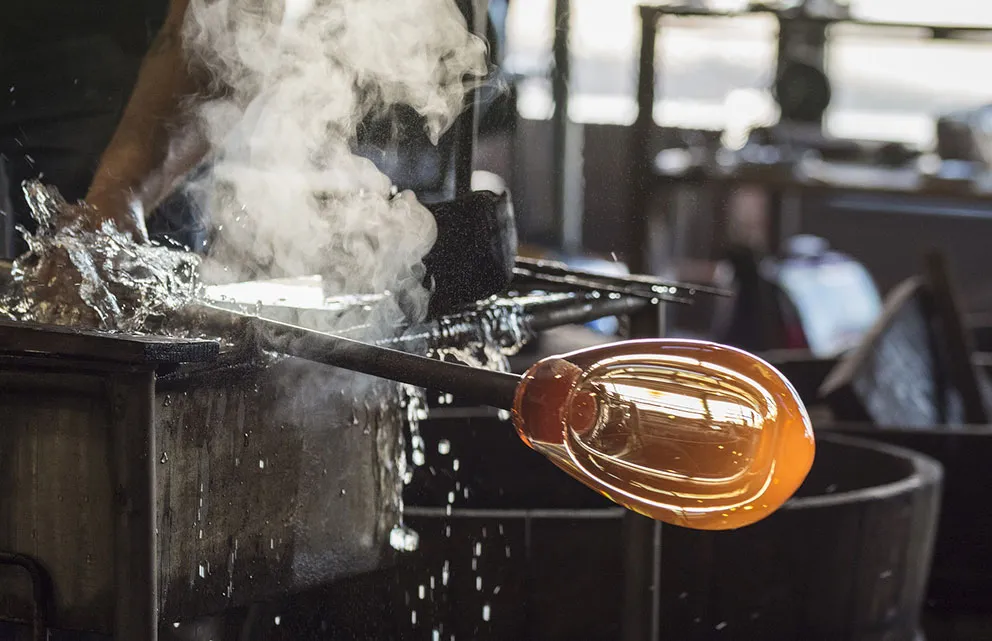
20th Century to Present: Modern Innovation and Expansion
The 20th century began with a breakthrough that would redefine glass bottle manufacturing: Michael J. Owens’ automatic bottle-making machine, introduced in 1903. This invention enabled mass production on an unprecedented scale. A single Owens machine could produce 13,000 bottles per day, dramatically lowering costs and reducing the need for highly skilled glassblowers.
By 1911, 103 Owens machines were operating in the U.S., with many more in at least nine other countries. Together, they produced hundreds of millions of bottles annually, supporting growing industries like dairy, beer, and condiments. Automation made glass packaging affordable and accessible for everyday products, not just luxury items.
A further advance came in 1925 with the introduction of Individual Section (IS) machines. These allowed multiple bottles to be made simultaneously in separate sections. Modern versions can include up to 20 sections, each producing several bottles at once. Factories now manufacture up to 700 bottles per minute, depending on size and design. Techniques such as “blow and blow” and “press and blow” help achieve precise and consistent results.
Bottle designs also evolved significantly over the past century. Customized containers were developed for pharmaceuticals, beverages, cosmetics, and specialty products—each tailored to preserve contents, support branding, or provide an upscale appearance. From the mid-1900s onward, environmental awareness led to the popularity of returnable and refillable glass bottles, reducing waste and promoting reuse.
Today, the industry emphasizes sustainability and efficiency. Lightweighting has made bottles thinner and lighter, saving energy in production and transport. Closed-loop recycling systems keep glass in use and out of landfills. Advanced inspection technologies like machine vision ensure high quality, while ongoing research explores more eco-friendly materials and lower-carbon production methods.
Glass remains a preferred packaging material for products requiring purity, freshness, and strong brand identity. Continued investment in manufacturing intelligence, material innovation, and sustainable practices reflects the industry’s commitment to combining traditional values with modern technology—and ensuring glass bottles remain both functional and environmentally responsible.
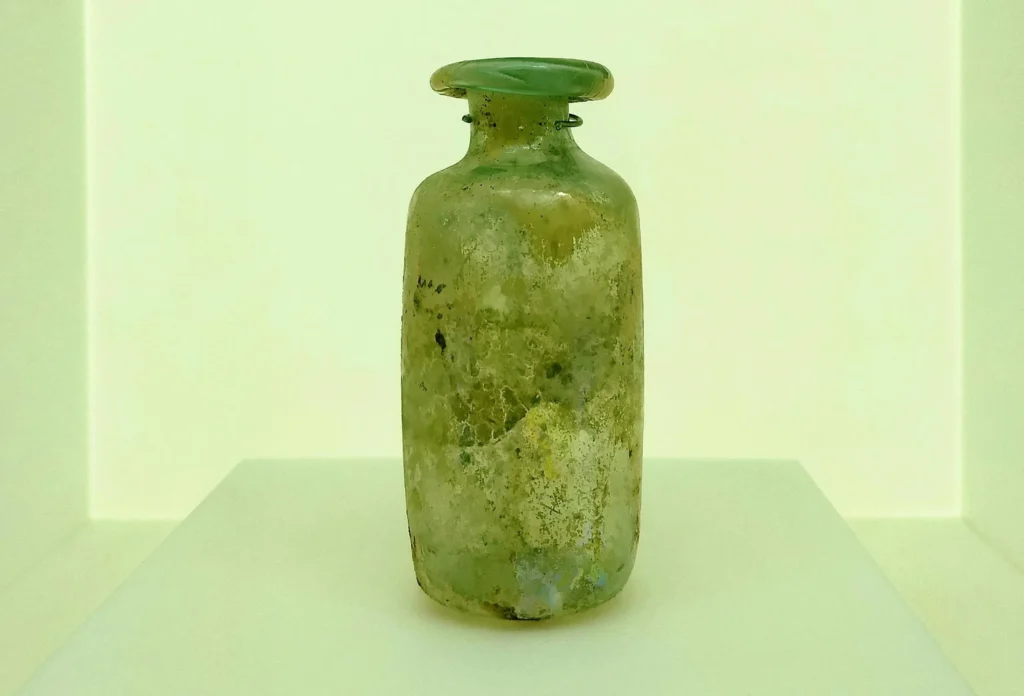
Conclusion
Throughout history, glass bottles have evolved from precious handcrafted vessels in ancient civilizations to today’s high-tech, sustainably produced containers. This journey reflects not only human ingenuity but also the enduring value of glass as a pure, reusable, and elegant packaging solution.
At TP Glass Bottle Manufacturer, we honor this rich heritage by combining traditional craftsmanship with state-of-the-art manufacturing technology. Whether you need custom-designed glass bottles for wine, cosmetics, pharmaceuticals, or specialty beverages, we deliver quality, sustainability, and elegance in every bottle. Let us help you bring your product vision to life with packaging that stands the test of time.

